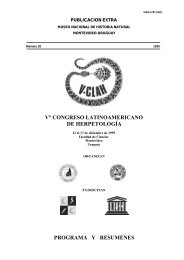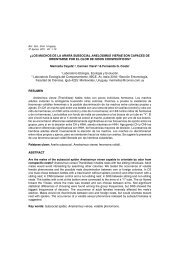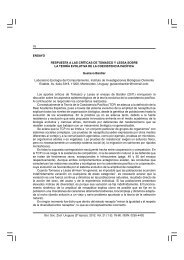Primer Congreso Uruguayo de Zoología - Sociedad Zoológica del ...
Primer Congreso Uruguayo de Zoología - Sociedad Zoológica del ...
Primer Congreso Uruguayo de Zoología - Sociedad Zoológica del ...
You also want an ePaper? Increase the reach of your titles
YUMPU automatically turns print PDFs into web optimized ePapers that Google loves.
ARE TADPOLE AND ADULT COMPOSITION OF ANURANS AFFECTED BY ON Pinus sp.NATURAL WIDESPREAD?Machado, I. F., Bairos Moreira L.F. & Maltchick L.Universida<strong>de</strong> do Vale do Rio dos Sinos – UNISINOS, Brazi. iberemachado@gmail.comAmphibians are among the most important organisms on mid-trophic level positions within most temperateecosystems, and their populations has showed a <strong>de</strong>cline mainly by factors like habitat loss and alteration of habitats.Pines have increased their ranges since colonization by man, and could wi<strong>de</strong>spread when habitat disturbance act ascause of invasions. This study analyzed the composition of adults and tadpoles assemblages, and how was therelationship of chemicals variables in 10 wetlands areas with invasive spread of Pinus and natural wetlands insouthern Brazil. Thirteen species were collected during the study period in the pine and in natural wetlands. Foradults, the mean richness and abundance was higher in natural than pine wetlands, over time and was higher innatural wetlands over all the study. The or<strong>de</strong>ring produced by NMDS showed that the 2-D axis explain 71,05% anurancomposition, the natural wetlands adult composition was relatively distinct from that found in pine wetlands, andwas related with redox potential. For tadpoles, we collected eleven species distributed in the pine (five species) andin natural wetlands (10 species). The mean tadpoles richness and abundance changed between pine and naturalwetlands, but not change over time and was higher in natural wetlands over all the study. The 3-D NMDS axis explain25,13% of the tadpoles composition variation. The tadpole composition in natural was distinct from that found inpine wetlands, but was not influenced by the chemicals variables. The results of this study suggest that the invasionof pine has a negative impact on the community structure, showed a reduction in anuran richness and abundanceand changes in its species composition. The conservation of aquatic ecosystems and the adoption of managementpractices are nee<strong>de</strong>d in southern Brazil, since over 90% of wetlands have been lost.UNA REVISIÓN SOBRE LA VISIÓN Y LA COLORACIÓN ULTRAVIOLETA EN AVESMachín, E. & R. Tosi.Asociación Averaves, Facultad <strong>de</strong> Ciencias, Iguá 4225, Montevi<strong>de</strong>o 11400, Uruguay.El auge <strong>de</strong> la biología molecular y los avances tecnológicos han brindado información que indica que la forma en quemuchos animales perciben la luz es muy diferente a la nuestra. Dichas diferencias radican en la estructura molecular<strong>de</strong> la retina ocular y en los diferentes fotorreceptores (conos y bastones) que la componen. La mayoría <strong>de</strong> los peces,reptiles y aves presentan cuatro tipos <strong>de</strong> conos, uno <strong>de</strong> ellos con sensibilidad máxima a la longitud <strong>de</strong> ondaultravioleta, lo que les proporciona una visión tetracromática. La visión UV <strong>de</strong>sempeña un papel importante en lapercepción <strong>de</strong>l mundo que tienen muchos organismos. En particular, para muchas especies <strong>de</strong> aves se ha propuestoque ésta juega un rol clave en su comunicación, la orientación <strong>de</strong> migraciones, el camuflaje, y en su alimentación.Hasta el momento, la bibliografía disponible señala que al menos 35 especies <strong>de</strong> aves son capaces <strong>de</strong> percibir luz conuna longitud <strong>de</strong> onda entre 320 y 400 nm (rango UV), mientras que para 347 especies se ha documentado que suplumaje refleja el UV. Los estudios sugieren que las aves que presentan reflectancia UV en su plumaje podrían utilizarestas señales visuales en la elección <strong>de</strong> pareja y el cuidado parental. El objetivo <strong>de</strong> este trabajo ha sido realizar unarevisión <strong>de</strong> los conocimientos que se tienen sobre la visión y la coloración ultravioleta <strong>de</strong> las aves, haciendo énfasisen las especies que habitan en el Uruguay. Conocer cuáles especies <strong>de</strong> aves <strong>de</strong> nuestro país presentan esta capacidadpermitirá, en un futuro, realizar entorno a ellas nuevos estudios comportamentales. Asimismo, esto aportaráinformación en lo que respecta a la comprensión <strong>de</strong> las señales y la visión <strong>de</strong> este grupo <strong>de</strong> vertebrados.<strong>Primer</strong> <strong>Congreso</strong> <strong>Uruguayo</strong> <strong>de</strong> <strong>Zoología</strong> 217







